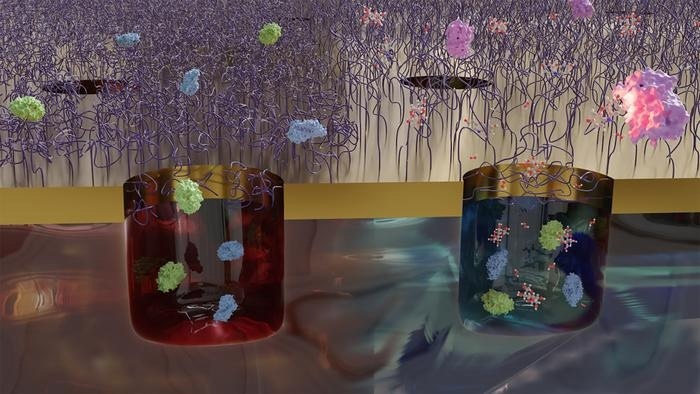Proteins that aggregate into clumps are common culprits in challenging-to-treat conditions like ALS, Alzheimer’s, and Parkinson's. Investigating how these proteins interact has historically been a complex task.
 The image shows the protein traps, which consist of nanoscale chambers and polymers that form gates above. These “doors” are opened up by increasing the temperature by about 10 degrees, which is done electrically. Then the polymers change their shape to a. Image Credit: Chalmers University Of Technology, Julia Jarlebark.
The image shows the protein traps, which consist of nanoscale chambers and polymers that form gates above. These “doors” are opened up by increasing the temperature by about 10 degrees, which is done electrically. Then the polymers change their shape to a. Image Credit: Chalmers University Of Technology, Julia Jarlebark.
However, researchers at Chalmers University of Technology, Sweden, have pioneered a novel approach: they have uncovered a method to confine numerous proteins within nano-sized traps. These traps offer an unprecedented opportunity to study these proteins in ways not previously possible.
We believe that our method has great potential to increase the understanding of early and dangerous processes in a number of different diseases and eventually lead to knowledge about how drugs can counteract them.
Andreas Dahlin, Study Author and Professor, Department of Chemistry and Chemical Engineering, Chalmers University of Technology
Clumping proteins underlie numerous diseases like ALS, Alzheimer's, and Parkinson's. Deeper insights into how these clusters assemble might unveil ways to dissolve them early on or halt their formation altogether.
While current techniques focus on studying late-stage clumps in their lengthy, chain-like structures, tracking the initial small-stage development has been a challenge. These innovative traps offer a promising solution, enabling researchers to explore these early developmental stages.
Can Study Higher Concentrations For Longer Time
The scientists characterize their work as creating the world's smallest gates that can be opened and closed at the touch of a button. These gates function as traps, effectively locking proteins inside nanoscale chambers.
The proteins are prevented from absconding, prolonging the observation time at this level from one millisecond to at least one hour. The novel method also enables it to enclose many hundred proteins in a small volume, providing a crucial capability for advancing our understanding of these biological structures.
The clumps that we want to see and understand better consist of hundreds of proteins, so if we are to study them, we need to be able to trap such large quantities. The high concentration in the small volume means that the proteins naturally bump into each other, which is a major advantage of our new method.
Andreas Dahlin, Study Author and Professor, Department of Chemistry and Chemical Engineering, Chalmers University of Technology
How the New Traps Work
The researchers have devised gates featuring polymer brushes positioned at the entrances of nano-sized chambers. These chambers contain proteins in a liquid solution drawn toward the chamber walls due to a specific chemical treatment. Once the gates are closed, the proteins can detach from the walls and begin to congregate.
The traps need to be adapted to attract the proteins that are linked to the particular disease you are interested in. What we're working on now is planning which proteins are most suitable to study.
Andreas Dahlin, Study Author and Professor, Department of Chemistry and Chemical Engineering, Chalmers University of Technolog
Within these traps, individual protein clumps can be examined, offering significantly more detailed information compared to analyzing multiple clumps simultaneously. This approach allows for the observation of diverse clumps formed through various mechanisms, differing in size and structure—an insight only achievable through one-by-one analysis.
While the proteins can be retained within the traps for extended periods, the duration is currently constrained by the longevity of the chemical marker needed to visualize them. In their study, the researchers achieved visibility for up to an hour.
Journal Reference:
Svirelis, J., et al. (2023). Stable trapping of multiple proteins at physiological conditions using nanoscale chambers with macromolecular gates. Nature Communications. doi.org/10.1038/s41467-023-40889-4.